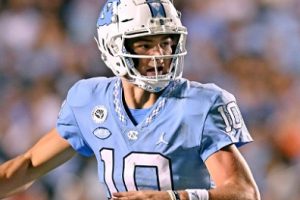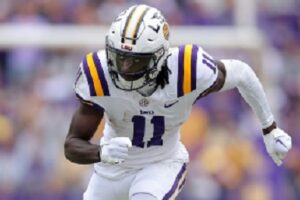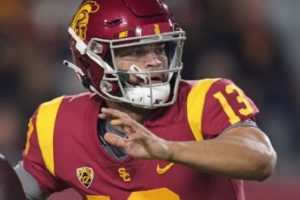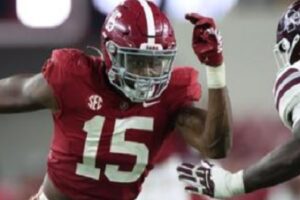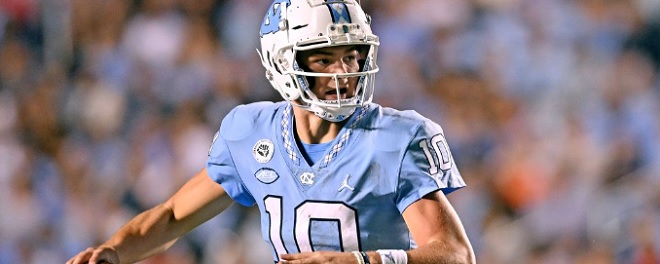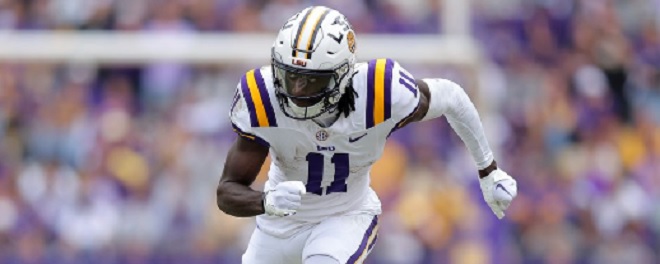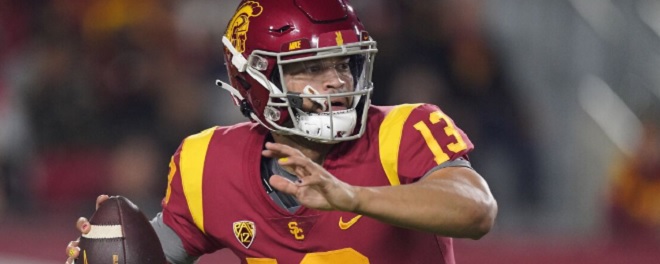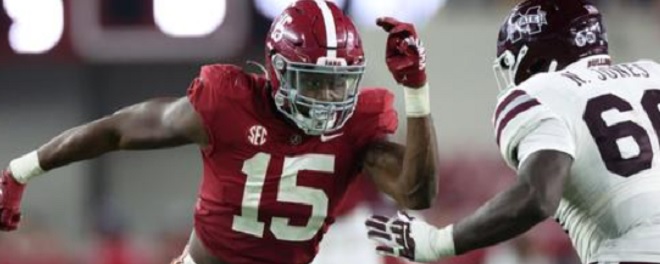By Charlie Campbell.
Send Charlie an e-mail here: [email protected]
Follow Charlie on Twitter @draftcampbell for updates.
This page was last updated April 10, 2018. Follow me @walterfootball for updates.
Position Review: 3-4 Outside Linebackers
3-4 Outside Linebacker Class
Early-round talent: C
Mid-round: C
Late-round: C
Overall grade: C
2018 prospects vs 2017
Myles Garrett
Tremaine Edmunds
Haason Reddick
Derek Barnett
Charles Harris
Marcus Davenport
T.J. Watt
Sam Hubbard
Arden Key
Harold Landry
Lorenzo Carter
Tyus Bowser
Ryan Anderson
Dorance Armstrong
Tim Williams
Chad Thomas
The 2018 NFL Draft is weak at defensive end, and that carries over for edge rushers who would fit a 3-4 defense. The lack of talent for pass-rushers in the first round of the 2018 NFL Draft carries into the rounds to come, and 2018 has much less talent than last year and is nowhere close to a really good year like the 2014 NFL Draft, which had Jadeveon Clowney, Khalil Mack and Anthony Barr.
The 2018 NFL Draft contains only two sure-fire first-round prospects for a 3-4 defense, and that is less than average. If you were to merge the two classes together, Garrett is the no-brainer top-ranked player. He was drafted into a 4-3, but like Jadeveon Clowney, the freak athlete also could play 3-4 outside linebacker. Tremaine Edmunds is a much better prospect than Haason Reddick, who was a big reach in the top half of the first round in 2017. Marcus Davenport is worthy of going in the back half of the first round, but he is not as good of a prospect as Derek Barnett or Charles Harris. T.J. Watt was a better prospect than Sam Hubbard, Arden Key, Harold Landry and Lorenzo Carter. Tyus Bowser and Ryan Anderson are second-rounders who would be behind that group. Dorance Armstrong and Chad Thomas are similar to Tim Williams as early third-rounders, but off-the-field issues pushed Williams into that portion of the 2017 NFL Draft.
Safest Pick: Tremaine Edmunds, Virginia Tech

The 19-year old Edmunds is a freak athlete with size, speed and athleticism. Over the past two seasons, the 6-foot-5, 236-pounder has been all over the field for Virginia Tech. In 2016, Edmunds recorded 106 tackles with 18.5 tackles for a loss, 4.5 sacks, three passes broken up, one forced fumble and one interception. As a junior, he totaled 109 tackles with 5.5 sacks, 14 tackles for a loss, two passes batted and three forced fumbles.
Edmunds is an excellent run defender. He has good instincts and is quick to read his keys. With his rapid reaction skills, he is always around the ball. Add that in with his explosive speed and athleticism, and Edmunds covers a ton of ground with a lot of tackles for a loss or near the line of scrimmage. He is also very well-suited for pass coverage in today’s NFL. As a professional, Edmunds could be an asset as a linebacker weapon to neutralize receiving-threat tight ends in man-to-man coverage. He functions very well in zone, too. Edmunds also could rush off the edge. He is a blank canvas who could play numerous positions in the NFL, including 3-4 outside linebacker, 3-4 inside linebacker, 4-3 inside linebacker and 4-3 outside linebacker. Edmunds has a ton of athletic upside and also gets high marks for his personal makeup. I think he is a safe bet to develop into a quality NFL starter.
My track record is here is good after a horrible start with Dion Jordan being one of the many busts from the first round of the 2013 NFL Draft. Jadeveon Clowney has become one of the best defensive players in the NFL. Dante Fowler broke out as a good player for the Jaguars during his third season. Joey Bosa has been excellent for the Chargers, and Garrett played well as rookie for Cleveland.
2017: Myles Garrett
2016: Joey Bosa
2015: Dante Fowler
2014: Jadeveon Clowney
2013: Dion Jordan
Biggest Bust Potential: Lorenzo Carter, Georgia

This was a tough decision, but Carter stands out to me as having serious bust potential. At Georgia, Carter never had one season of big potential despite seeing a lot of playing time in all four years. His best play came as a senior, when he still had totaled fewer than 60 tackles (57) and five sacks (4.5). The 6-foot-5, 250-pounder is big, long, fast and athletic. It didn’t make sense to me why he didn’t dominate and was so inconsistent, only flashing occasionally. Team sources told me that Carter has dedication issues and gets by on a lot of natural ability. That put it over the top for me as the dedication issues and lack of love of football explains why Carter was an underachiever in college.
I have a pretty good track record here. Obviously, you can’t make any judgements on McKinley after one season. The jury is still out on Noah Spence after he missed most of his second season with an injury. I was correct on Gregory and Mingo being potential busts. Dee Ford had a good 2016 season, but his other three seasons have been underwhelming. Still, I wouldn’t count Ford as a bust.
2017: Takk McKinley
2016: Noah Spence
2015: Randy Gregory
2014: Dee Ford
2013: Barkevious Mingo
3-4 Outside Linebackers Rankings by Attributes
Pass Rush:
NFL prototype: Khalil Mack, Raiders
- Harold Landry
- Arden Key
- Dorance Armstrong
- Tremaine Edmunds
- Sam Hubbard
- Chad Thomas
- Marcus Davenport
- Lorenzo Carter
Recap: The NFL is a passing-driven league, and 3-4 defenses need edge-rushers who can consistently get to the quarterback. Rushing the passer is the primary responsibility for a 3-4 outside linebacker. Some college defensive ends can struggle to make the transition to rushing off the edge as they move out wider from offensive tackles. Other players thrive with the change.
Landry and Key are virtually tied for this. Both were awesome as pass-rushers in 2016 and then had 2017 hampered by injuries. Landry is a fast edge rusher with speed and athleticism off the edge. He only had five sacks last year while missing time with an injury, but he notched 16.5 sacks during the previous year. If Landry can get back to his 2016 form, he could quickly create an impact in the NFL. Landry could stand to get stronger for fighting off NFL offensive tackles.
If Key had duplicated his 2016 season in 2017, he would be No. 1 here. As a sophomore, Key was a pass-rushing force with speed, a repertoire of moves, and a natural nose for the quarterback, recording 12 sacks. As a junior, he was too heavy coming off injury, but he flashed his old form at times. If Key stays out of trouble, he could be a dynamic pass-rusher in the NFL capable of sack totals in the teens.
In 2016 as a sophomore, Armstrong put together some serious production with 10 sacks, 20 tackles for a loss, 56 tackles and three forced fumbles. His production declined in 2017 because he saw a ton of extra blocking with plays deliberately going away from him while teams blew out the Jayhawks. Still, Armstrong is a fast and twitchy athlete who could be an excellent pass-rusher in the NFL.
Edmunds is a bit of a projection, but I think he has the potential to be an impactful edge rusher in the NFL. He notched 10 sacks over the past two seasons, but that total could have been a lot larger if he had received more pass-rushing opportunities. In a 3-4 defense, I think Edmunds could be a dangerous quarterback hunter as an outside linebacker with his speed, size, athleticism and instincts.
Hubbard and Thomas both flashed serious potential, but both were inconsistent in college. Hubbard has the skill set to be a good pass-rusher. He is strong, thick, quick and athletic, but didn’t always produce up to his skill set. Thomas has an excellent skill set with speed and athleticism, but he was an underachiever in college and his focus may not be entirely on football. If he had played up to his skill set, he would be a lot higher on this list and go a lot higher in the 2018 NFL Draft.
Davenport (6-5, 259) has the skill set to be very good with the pass rush, although he still needs a lot of development. For a tall edge defender, Davenport plays with very good leverage. He doesn’t stand up too high and stays low to get underneath the pads of offensive tackles. Davenport definitely needs to add more pass-rushing moves, as he is too reliant on a bull rush. That is what he used on the majority of his rushes. One striking issue when watching Davenport is that he must improve his get-off. When the ball is snapped, Davenport takes a second to size up his blockers rather than firing out of his stance. Team sources say that Davenport is very raw to the point that he doesn’t know what he is looking at on some plays and is going to see massive jump in the quality of competition. Thus, Davenport is rated lower right now; however, in a few years, he could among the best pass-rushers to come from this draft because of his good skill set.
Carter is lower on this list because despite seeing a lot of pass-rushing opportunities at Georgia, he was an underachiever. Carter possessed the skills to dominate, but allowed plenty of lesser talented players to get the better of him. He had 4.5 sacks last year and five the year before. One team source also pointed out that the SEC has not featured a lot of good offensive tackles in recent years. That further supports that Carter should have been a double-digit sacker given his skill set. He is a boom-or-bust player with great potential but a complete lack of consistency.
Run Defense:
NFL prototype: Jadeveon Clowney, Texans
- Marcus Davenport
- Tremaine Edmunds
- Sam Hubbard
- Dorance Armstrong
- Arden Key
- Chad Thomas
- Harold Landry
- Lorenzo Carter
Recap: Many 3-4 defenses typically don’t require their outside linebackers to be an asset against the run because they rely on their 3-4 defensive ends, nose tackles and inside linebackers to lead the way in run defense. However, the success of the read option is changing that as the edge linebackers play a critical role in defending against it. Being tough versus the run could become a more important attribute in the seasons to come.
Davenport is excellent in the ground game. He is strong at the point of attack and pushes around the blockers. Davenport is able to hold his ground and stand up offensive tackles to maintain gap integrity. He also has the strength to shed blocks and the quickness to close on the running back to make tackles outside of his gap. Entering the NFL, Davenport is an excellent run defender.
Edmunds is another great run defender. He has good instincts and is quick to read his keys. With his rapid reaction skills, he is always around the ball. Add that in with his explosive speed and athleticism, and Edmunds covers a ton of ground with a lot of tackles for a loss or near the line of scrimmage. He is a skilled defender at producing a lot of good down-and-distance situations for his defense. Edmunds gave Virginia Tech a lot of second-and-8s, third-and-7s, and consistently put his defense in good position. Edmunds has the size and strength to take on blockers, plus the speed to cover the perimeter. He also is a hard tackler who wraps up ball-carriers and puts hard them to the turf. With his versatile skill set, Edmunds could be a middle or outside linebacker in the NFL.
Hubbard (6-5, 270) was a quality run defender for Ohio State. He is strong at the point of attack and sets a sturdy edge. Hubbard had almost 90 tackles over the past two seasons despite being in a rotation. In the NFL, he should be a solid run defender.
Armstrong had 63 tackles as a junior with 56 the previous year. He plays hard against the run and chases down backs. However, Armstrong is undersized for the NFL and could have issues with the length and strength of offensive tackles.
Key had some good moments as a run defender in 2016, but he wasn’t overly impressive in this regarding 2017. Thomas was unimpressive against the run with 30 tackles in 2017 and 37 tackles the previous year. He could be a better run defender if he were more focused and consistent.
Landry’s run defense was awful in 2017. He struggled to get off blocks and didn’t look that interested in fighting to hold his ground or get in on tackles. Landry’s run defense was a liability when he was on the field, and he has to get much better in the NFL to become a three-down starter. His run-defense issues would be decreased by playing in a 3-4 with a five-technique to help occupy offensive tackles. In a 4-3 defense, Landry would be a real weakness in run defense.
Carter has the size, strength, length and speed to be a good run defender, but he never became that at Georgia. Over his four seasons of playing time his tackle totals were: 41, 19, 44 and 57. Carter should have produced a lot more, and his effort or lack thereof is a big contributing factor.
Dropping Into Coverage:
NFL prototype: Clay Matthews, Packers
- Tremaine Edmunds
- Dorance Armstrong
- Lorenzo Carter
- Harold Landry
- Marcus Davenport
- Arden Key
- Sam Hubbard
- Chad Thomas
Recap: The NFL is a passing-driven league, and 3-4 defenses need linebackers who can function in space while dropping into pass coverage. The 3-4 defense is predicated on variety, so it requires linebackers to fall back into pass coverage to avoid predictability.
This group doesn’t have a lot of experience dropping into coverage. It isn’t surprising, because these prospects were the best pass-rushers on their teams, so having them drop into coverage didn’t make a lot of sense for their college programs.
Edmunds is very well-suited for pass coverage in today’s NFL. As a professional, he could be an asset as a linebacker weapon to neutralize receiving-threat tight ends in man-to-man coverage. He has good height and length to match up on tight ends and the speed to get down the seam. For running backs out of the backfield, Edmunds is also a good weapon to defend them as he is fast to the flat and is an excellent open-field tackler. He was very good in zone coverage for Virginia Tech over the last two seasons. Edmunds is comfortable in space and uses his excellent closing speed to hunt down ball-carriers. In zone coverage, Edmunds is skilled to pick up receivers coming into his area and keeping them from getting open. The freak athlete has drawn comparisons to Brian Urlacher.
The next four players I think have potential to be good at dropping into coverage in the NFL. Carter and Davenport have some coverage ability with their respective speed, length and athleticism. They will both need development, but each has the skill set to do it. Armstrong didn’t drop in coverage at Kansas because he was the team’s only good pass-rusher. However, he looked good in linebacker drills at the combine. Armstrong will need more development for the NFL. Landry was the same at Boston College while flashing that skill in workouts. I think both could develop into being 3-4 outside linebackers who are solid at falling back into pass coverage in the NFL.
Key, Hubbard and Thomas didn’t drop enough in college to render a real judgement, but they all are good athletes who could learn to do it in the NFL if they are drafted into a 3-4 and placed at outside linebacker.
Shedding Blocks:
NFL prototype: Khalil Mack, Raiders
- Marcus Davenport
- Tremaine Edmunds
- Arden Key
- Sam Hubbard
- Chad Thomas
- Dorance Armstrong
- Harold Landry
- Lorenzo Carter
Recap: Outside linebackers in a 3-4 need the strength to fight off offensive linemen, especially when teams slide protections their direction with double teams. Having the power to shed blocks separates the effectiveness of a lot of players.
In this category, Davenport really stands out. He has the strength to shed blocks and the quickness to close on the back to make tackles outside of his gap. With his natural strength, athleticism and quickness, Davenport is very difficult for offensive linemen to block.
Edmunds is very adept at taking on shedding blocks. He uses his strength and length to disengage and then his explosive speed to dart away. Edmunds could end up becoming the prototype pick for this category during his NFL career.
Key was very skilled at getting off blocks as a sophomore, but he had some real struggles in this regard as a junior. If he can get back to his 2016 form, getting off blocks will be a strength of his as a player.
Hubbard and Thomas have the size and strength to be functional at getting off blocks, but both of them were consistent enough at it. Armstrong and Landry were good at getting off blocks when it came to rushing the passer. However, they both could stand to get better at shedding blocks in the ground game for the NFL. Carter has the ability to get off blocks, but he doesn’t do it consistently enough.
Motor:
NFL prototype: James Harrison, Steelers
- Tremaine Edmunds
- Marcus Davenport
- Dorance Armstrong
- Sam Hubbard
- Arden Key
- Lorenzo Carter
- Chad Thomas
- Harold Landry
Recap: The majority of great pass-rushers have motors that don’t quit. Effort can make the difference between an edge rusher having 12 sacks in a season versus eight.
Edmunds has a relentless style of play. Every snap sees him looking to make a play, and he always gives good effort. Davenport and Armstrong definitely have good motors. They don’t quit on plays and fight through the whistle. Even though they faced a lot of double teams, they both fought hard to make plays.
Hubbard’s motor looked fine at times and then at other times you would wonder why lesser players were blocking him successfully. It makes one wonder if the motor is one of the reasons for his production never living up to his skill set. Key had a good motor at times and underwhelming at others. As a junior, he was injured and overweight. That depressed his activity.
Carter, Thomas and Landry all underwhelm with their motors. Carter and Thomas have the skill set to do anything they want on a football field, yet they ran hot and cold. In their cold stretches, they were ghosts. Landry gives a good effort as a pass-rusher, but his run-defense motor was awful at times in 2017 – see the Notre Dame and Clemson games. At times, he didn’t look interested. He was playing injured, so perhaps that led to him trying to protect himself and save himself for pass-rushing situations. Still, his motor needs to be better in the NFL.
Splash Plays:
NFL prototype: Von Miller, Broncos
- Harold Landry
- Dorance Armstrong
- Tremaine Edmunds
- Arden Key
- Marcus Davenport
- Lorenzo Carter
- Sam Hubbard
- Chad Thomas
Recap: Defenses and teams thrive off turnovers, so pass-rushers who have the skills to force fumbles are game-changers. Many players go for strip sacks, but some are more effective than others.
You might be surprised that I have Landry ranked at the top here considering he had zero forced fumbles last year. However, he leads all of these prospects with 10 career forced fumbles. When Landry was doing well in 2016, he was dangerous to produce the strip-sack, notching had seven forced fumbles that year, which is a huge total for an edge rusher. Landry has good instincts to go for the ball and could produce a nice amount of fumbles for his pro defense.
Armstrong wasn’t far off in that he had four forced fumbles as a junior and three as a sophomore. Edmunds produced a number of splash plays with forced fumbles, interceptions and sacks. He has the upside to do that even more in the NFL.
Key and Davenport each had seasons with three forced fumbles. Both have shown the potential to produce them in the NFL. Carter totaled three forced fumbles last year and showed some big-play potential.
Hubbard had two forced fumbles last year with zero the previous season. Thomas totaled zero forced fumbles as a senior, one as a junior and one as a sophomore. He also only recorded 10.5 sacks in college. Thomas didn’t produce splash plays for Miami.
2024 NFL Mock Draft - April 23
NFL Power Rankings - Feb. 22
Fantasy Football Rankings - Feb. 19
NFL Picks - Feb. 12

